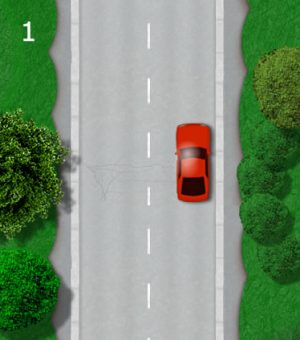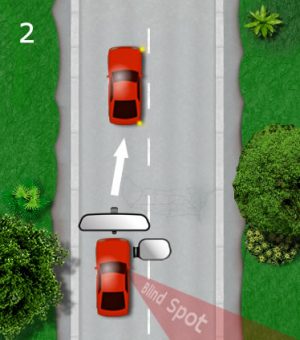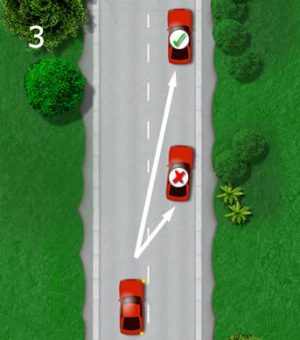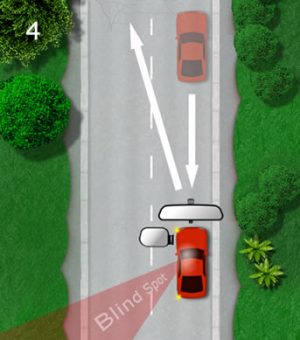Pulling up on the left has been a part of the driving test for many years. The new practical driving test will see the introduction of a new manoeuvre; pulling up on the right and reversing two car lengths.
Pulling up on the right, or parking on the right involves driving against and parking against the traffic flow and as such, the controversial manoeuvre has caused much debate, particularly as the Highway Code does not recommend it. It may also be worth noting, it is illegal to park against the traffic flow during the night unless in a recognised parking space.
Regardless of opinion, it will become a part of the UK driving test in December. Though a relatively simple procedure, the manoeuvre, hazardous by nature can easily fail a driving test unless it is performed correctly.
This tutorial will explain how to pull up on the right, along with reference points to gain good positioning, plus a section covering mistakes that should be avoided.
What is the Examiner Looking For?
The examiner is looking for a demonstration of three key skills. These are:
- Control – to move the car slowly, under full control
- Accuracy – good road positioning throughout the manoeuvre
- Observation – to be fully aware of your surroundings, other road users, pedestrians and the ability to act accordingly given changing circumstances
How to Pull up on the Right
The examiner will ask you to pull up on the right when it’s safe to do so. You will be in a location that the examiner has specifically chosen that is suitable for the manoeuvre. For example, if the road is quite busy, then there will be plenty of room to park safely on the right. There will not be parking restrictions in place such as double yellow lines.
You will not be required to pull up on the left before carrying out this manoeuvre. This tutorial assumes you already have knowledge on how to correctly stop a car.
1. Pull up on the Right in a Suitable Location
Once the examiner has given instruction, observe and locate a safe place ahead to stop on the right-hand side of the road. It’s not a requirement that you must stop behind another vehicle. There might be a situation where you have to stop behind another vehicle, or circumstances might change, for instance a vehicle pulls up just in front of you. This will be covered later.

- If possible, avoid parking directly behind another vehicle. Though you will be reversing, it will obscure your view of the road ahead, making pulling away harder than is perhaps otherwise necessary.
- Avoid pulling up too close to a junction or opposite a junction.
- If possible, avoid stopping directly across a driveway where you may impede a driver from entering or leaving their premises.
- Unless the road is particularly wide, avoid stopping directly opposite a vehicle that is parked on the left as this may impede other road users progress.
2. MSM and Road Positioning
Once you have located an ideal place to pull over on the right, use the MSM routine. Look into your interior mirror, then your right door mirror, followed by a quick glance into the right blind spot. Then if all is clear, signal to the right.

- Position your vehicle to the left of the centre of the road (right side of your lane), just as though you were making a right turn.
- Be prepared to stop and give way to oncoming vehicles.
- If you do need to stop and give way to oncoming vehicles, take another glance into your mirrors and blind spot before proceeding.
3. Pull Over to the Right
Make your way over to the right-side of the road, using a reasonably shallow angle. Moving across the road at a steep angle increases the potential of hitting the kerb. This also makes it harder to stop parallel with the kerb and with straight wheels.

- Before moving to the right-side of the road and if you do need to stop and give way for oncoming vehicles, leave a good distance from where you have stopped to give way and from where you intend on pulling up (think around 8 car lengths). This will avoid pulling up using a steep angle.
- You’ll need to stop reasonably close to the kerb, around 20 to 30 cm is fine.
- Avoid hitting the kerb as this will likely result in a test failure.
- You will shortly be reversing, so to make the situation easier for yourself, stop straight (in line) and parallel with the kerb and stop with your wheels straight.
- Cancel your signal if applicable and if you have stopped on a slight slope and if there’s a risk of rolling, you may apply the handbrake once stopped if you wish to do so.
4. Reversing and Moving Off
The examiner will now ask you to reverse for around two car lengths. If you have stopped straight and parallel with the kerb and with straight wheels, this should be an easy process.

- Select reverse gear and before moving backwards, take a look ahead to ensure there are no oncoming vehicles. If there are, wait for any vehicles to pass. If all clear take a look into your mirrors, then finally look in the direction you’re going – out the rear window.
- Whilst looking out the rear window, begin reversing slowly – think slow walking pace. Continuously look around in all directions. If there are vehicles passing on the same side of the road as you, stop and wait for them to pass. If there are passing vehicles passing on the opposite side of the road, you should be safe to continue. If another vehicle pulls in either in front or behind you, stop and wait until they have finished moving.
- When you have reversed approximately two car lengths, or the examiner asks you to stop, stop the car, apply the handbrake and select neutral. The examiner will now ask you to move away when you’re ready.
- To move away safely, select first gear, look ahead to ensure all is clear, look into the interior mirror, the left door mirror and look over your left should into the blind spot. Look ahead and if is clear, signal to the left and move off.
Complications and Reference Points
The pulling up on the right exercise will in most cases go without issue. There are of course complications that may arise and this guide explains the potential issues and what should be done. Manoeuvres are always made easier with the use of reference points that allow a driver a better understanding of where their vehicle is.

This test just gets worse. No one ever ever drives like they are expected to do in a test.
I drive a Saab Convertible which I’m taking to the test on Saturday. I have no idea how straight I am to the kerb without opening the door. Who am I ? James Bond. Reversing two car lengths without checking my mirror to see if I’m still straight.
Do you always have to look behind when reversing ?
My wing mirrors don’t allow me to see the kerb along the car.
Hello Paul,
Once you have pulled up on the right, look out the rear just before and just as you start reversing. You do this because it’s the direction you’re moving in. Just after you start reversing, you can look around, but the main observation must be in the direction you’re moving in. You can adjust your side mirrors just before you reverse to see the kerb is you wish, just remember to set them back before moving off forwards.
Just on another note; if you haven’t already, it might be worth checking with the DVSA whether or not your car is acceptable for the driving test – they don’t like convertibles too much.
Should hazard lights be turned on when pulled up on the right before reversing back 2 car lengths? That’s what my driving instructor tells me to do when practicing but I’ve not seen this stated anywhere when reading online about this manoeuvre. Thanks.
Hello Lyndsay,
No, do not put your hazard lights on when pulling up on the right. This can cause other road users confusion for example, if the indicator closest to the kerb is blocked from the view of an oncoming road user, it can give the impression that you’re signalling to come out. You do not need to use hazard lights at any point during this manoeuvre.
You can not take a test in a convertible
Should you indicator before pulling over if there is no one around?
Hi Becca,
It’s the same principle as pulling up on the left; there’s no obligation to do so providing your actions do not impact on others. Though you can indicate regardless if you wish.
Good morning, during the reverse stage, should the student wish to check a) the road remains clear from the front or b) an offside mirror to ensure they remain clear of the kerb – would you recommend they temporary stop the vehicle or simply conduct a quick reference check whilst continuing to reverse. Mindful of the latter resulting in not looking in the direction of travel.
When I have previously taught reversing around a corner I always encouraged the student to momentary stop and check to the front and then offsite mirror before turning the wheel. Appreciate your views and great subject coverage – thanks.
Hello Dave,
I have always taught learners to carry out manoeuvres very slowly and to regularly stop. For a learner, it’s an awful lot to do a manoeuvre, both in terms of controlling the vehicle and to carry out effective observations. Regularly stopping the car to make observational checks does slow things down but also makes it much safer. I also find that by having regular ‘stops’ during a manoeuvre, it breaks the process down into separate phases, making it easier for them to remember.
hi when u do the reverse part do u keep right signal on ?
Hello iks,
No, when you have pulled up on the right and stopped, cancel the signal.
Is this manoeuvre on the test now or does it start from December 2022?
Hi Andy,
This manoeuvre is on the driving test now. The pulling up on the right manoeuvre began on the DVSA’s driving test in December 2017.
When it comes to manoeuvres, are you able to make corrections as long as is safe to do so, without getting a minor mark? For example: You try reverse bay parking, but have to pull forwards a bit to align the vehicle.
As long as it’s safe and I am in control of the vehicle I don’t see a problem with this, I just want some clarification. There are some places you have to adjust to reverse park anyway?
Hi Haydn,
Yes, as you say, provided that you do so safely, you can make corrections, just as you would do in real life driving. If during the driving test you feel that your manoeuvre is going wrong, definitely make adjustments, or even start again if you have to. Examiners do vary on the amount of adjustment they permit to consider a pass, and some may give a minor if they consider it too much, but a minor is far better than failing due to messing the manoeuvre up.
My car TPMS light is on because of one missing sensor. However, I regularly checks for tire pressure. Can I take my car for driving test?
Hi Aditya,
Personally I wouldn’t risk it. Probably best to get the sensor replaced before your test. If you happen to have a pressure gauge you take to show the examiner that the pressure is fine, it might help, but still, I personally wouldn’t risk it.
Hi, I just wanted to ask.. if pulling up on the right. If I took the first spot that was free to park in but it was inbetween two cars (not giving room to reverse) would I fail? I’ve been told that I need to park in the first space and not hesitate in doing so, I chose to carry on further down where it was safer and had a lot of spare space that’s all but they was a small space further up when I got asked to pull up on the right.. just confused as I have my test soon
Hi Ash,
No, you wouldn’t fail (provided you did everything safely of course). But don’t make it hard on yourself by squeezing into a small space. Do that, and you make things far harder for yourself. As you say yourself, carry on down the road until you find yourself a safer and easier place to park – just as you would in real life. If you take all day trying to find somewhere to do it, that might be a problem, but you certainly don’t have to stop in the first gap that you see. On the other hand, the examiner may ask you to stop in a specific place. Good luck on your test!